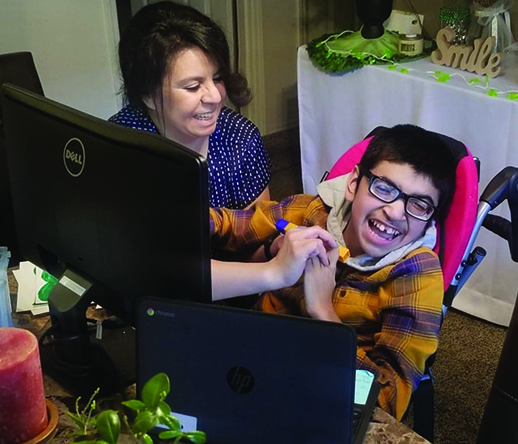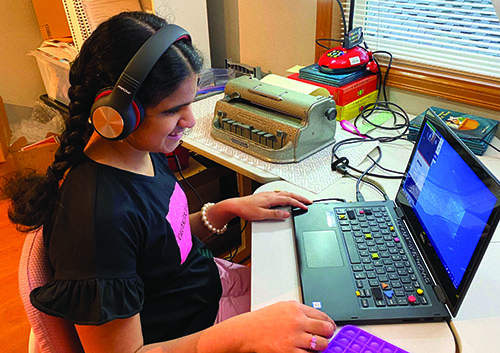“ We just finished e-learning, so I feel like we just finished a grand adventure.” —English-speaking parent of an 8-year-old who is blind
“I think overall, COVID has been good for us. The time I’ve had at home with my kids has given me a lot of time to think and learn and decide what’s important.” —English-speaking parent of a 5-year-old and a 3-year-old with low vision
While the pandemic presented many challenges for students and families, it also brought some unexpected benefits. Family members became more involved in their children’s education and more aware of gaps that they needed to address. Some children exhibited less stress, gained new skills, and took time to explore their passions. The pandemic led some families to opt for other school placements for their child, often to a placement that provided more individualized attention for the child.
Increased Family Involvement
Some family members reported that by joining their children in remote learning, they gained a better understanding of their children’s educational needs, challenges, and solutions. Educators, meanwhile, appreciated the increased collaboration with families. Representative quotes included:
“I want to emphasize how nice as a parent it was to see the interactions between [child] and the teachers. Observing how well they worked together. A lot of parents drop kids off and it’s out of sight, out of mind. I loved being this fly on the wall, seeing how amazing and creative our teachers at [child’s school] were.” —English-speaking parent of a 15-year-old who is blind
“As hard as the pandemic was, we learned some really valuable lessons, and I am inherently grateful that it happened. The lack of tech training in mainstream tools was a big glaring hole for us that I didn’t know was a hole because in person she could successfully complete her work. Until I had to sit with her and see where she was struggling, I didn’t know how to advocate well for that.” —English-speaking parent of a 16-year-old who is blind with additional disabilities
“I think it was a great opportunity for parents to become more actively engaged. That short period of virtual instruction they had to take the reins. I noticed more follow-through later in the year. Parents do want to be involved; we need to be touching base more often even when we’re not doing virtual learning. It was a great reminder to keep in contact more frequently with them.” —TVI
“One of the real positives [of the pandemic] is that a lot of our families who would sit with their child during virtual instruction learned more about their child’s visual impairment and the accommodations their child needs.” —Administrator of a school for the blind
Decreased Stress and Demands
The pandemic intensified anxiety for some children, but others experienced less stress due to a slower pace of life, fewer demands, and less social pressures. Some children showed academic improvement while learning from home without the distractions inherent in a classroom environment. To compensate for the loss of in-person social activities, some children joined virtual social clubs or gained new relationships with mentors working with them individually. Some representative quotes on this theme included:
“In a weird way I think she benefited socially from remote learning. On Zoom she was speaking up more than she would be in person.” —English-speaking parent of a 15-year-old who is blind
“The pandemic helped us slow down. It helped me have the opportunity to see in real time how things flowed with school. We’ve had more time to work on independent living skills; before, the weekdays were too rushed.” —English-speaking parent of a 19-year-old who is blind with additional disabilities
“When I discussed with him on how he’s doing, he’s doing really well because he doesn’t have the distractions of the classroom with 17–20 kids in a loud classroom.” —English-speaking parent of an 8-year-old who is blind
Development of New Skills
During remote learning, some students developed their technology and self-advocacy skills as a part of learning to manage new learning systems and coping with access challenges. The reduction in scheduled activities also offered students more time to explore their passions. One parent said:
“I feel like the pandemic has made my children stronger. They have built their tech skills. It’s given them time to delve into their interests.” —English-speaking parent of an 11-year-old and an 8-year-old with low vision and additional disabilities
Similarly, a TVI described her student’s growth in technology skills:
“We got [student] to connect to the Internet, set up email, just on the phone. Once she was able to connect and communicate by email, it was a game changer for her. One of my goals was getting her ready for middle school. She really took off after she realized hey, I can communicate with everybody on my own!” —TVI
Opportunity to Modify School Placements
Some families shared that during the pandemic, they decided to modify their children’s school placement, such as moving from a public school to a school for the blind or to homeschooling, modifying IEP goals, or increasing specialist service time. This often occurred after families became more aware of the inaccessibility or inadequate accommodations their children were receiving in the public school setting. For example:
“I think overall I can make [older child’s] education a priority with homeschool. I saw how quickly my daughter’s education dropped to a very low priority for the district when things shut down. When things get hard my kids are going to be among the first whose education gets dropped. Once you know that, it’s hard to go back.” —English-speaking parent of a 5-year-old with low vision and additional disabilities and a 3-year-old with low vision
“I think it’s a blessing that [the pandemic] happened because it made us rethink her time with her educators…Now she’s getting JAWS training 4 days a week, and I don’t think that would have happened if not for the pandemic.” —English-speaking parent of a 16-year-old who is blind with additional disabilities
“Matter of fact, we had the largest enrollment influx in our Blind Department this past fall. I think a lot of it was because of the struggles the LEAs [Local Education Agencies] had to meet their needs when they were at home. They weren’t prepared to have that level of support. So, I think we enrolled over 12 students in our Blind Department in the fall.” —Administrator of a school for the blind

